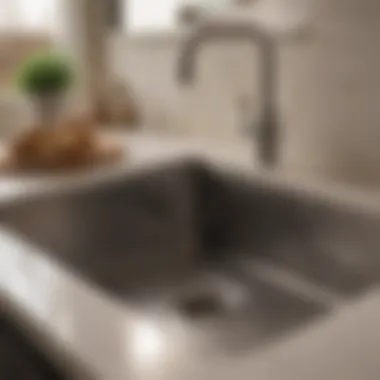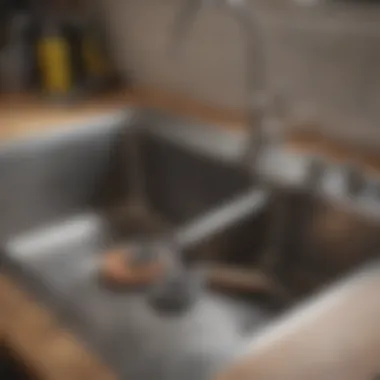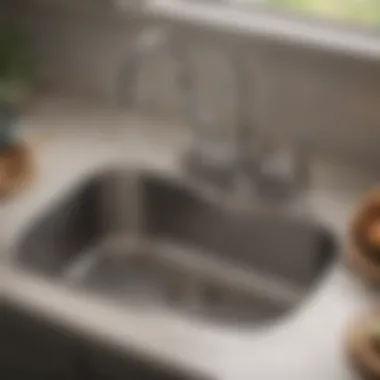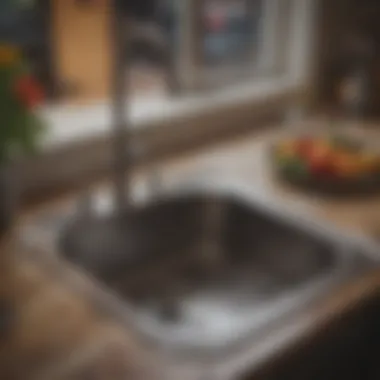Essential Guide to Cleaning Your Kitchen Sink Disposal


Intro
Maintaining a clean and functional kitchen sink disposal is more than just a chore; it's essential for the smooth operation of your kitchen's plumbing system. This small but impactful appliance plays a pivotal role in waste management in homes, especially in our fast-paced lifestyles. Understanding how to clean and maintain this system can save homeowners from costly repairs or replacements down the line.
Proper care ensures not only efficiency but also hygiene, as food residue can lead to unpleasant odors and even attract pests. The following sections will cover various facets of sink disposal maintenance, from practical tips and cleaning techniques to common issues and preventative measures.
Maintenance & Care
Regular maintenance of your kitchen sink disposal can significantly enhance its lifespan. The mechanics of these disposals are simple; they grind food waste into tiny particles, which are then washed away by water. However, neglect can lead to clogs and malfunctions. Here are some practices to keep in mind:
- Run Water While Operating: Always keep water flowing while the disposal is in use. This helps push debris down the drain and prevents buildup.
- Cold Water is Best: Use cold water instead of hot. Cold temperatures help solidify any grease, making it easier for the disposal to grind.
- Clean Regularly: It's advisable to clean your disposal at least once a week. You can use ice cubes and rock salt to remove any buildup.
- Use Baking Soda and Vinegar: A mixture of baking soda and vinegar can help neutralize odors and clean the disposal. Pour one cup of baking soda followed by one cup of vinegar. Allow this to sit for about 15 minutes, then flush with cold water.
"Regular cleaning not only keeps your disposal smelling fresh but also helps prevent future clogs."
Common Issues
Understanding common issues with kitchen sink disposals will aid in preventative maintenance. Some of the most frequent problems include:
- Jamming: This often occurs when hard food items, such as bones or fibrous vegetables, enter the disposal. In such cases, it is important to turn off the disposal and use the reset button before troubleshooting.
- Unpleasant Smells: These can arise from rotting food particles stuck in the disposal. Regular cleaning is essential to combat this.
- Leaks: If you notice water pooling under the sink, it may indicate a leak in the disposal unit or connections.
Preventative Measures
Several measures can help prevent potential issues with your kitchen sink disposal:
- Limit What Goes In: Be conscious of what you put into the disposal. Avoid hard, fibrous, or starchy foods.
- Routine Inspections: Regularly check the appliances and plumbing for leaks or signs of wear.
- Educate Household Members: Ensure everyone in the household knows how to properly use and maintain the disposal to minimize mishaps.
Foreword to Kitchen Sink Disposals
Kitchen sink disposals are an essential appliance in modern kitchens. They provide convenience by allowing homeowners to eliminate food waste quickly and easily. However, to maintain their functionality, it is important to understand how they work and consider their maintenance needs. This section will delve into the functionality and types of kitchen sink disposals to give a clearer insight into their role in a household.
Understanding the Functionality
The primary role of a kitchen sink disposal is to process food waste. When food is introduced into the disposal unit, it is shredded into small particles, which can then be washed away with water through the plumbing system. This process not only simplifies meal cleanup but also helps in reducing the volume of waste that goes to landfills. Understanding this basic functionality is crucial because it emphasizes the role of routine cleaning and maintenance in ensuring its optimal performance.
Cycling through a variety of food scraps daily can lead to potential issues, such as clogs or foul odors, if not handled properly. Knowing how a disposal works can inform better practices on what to dispose of and how to maintain clean functionality. Sourcing quality materials also plays a role, as some units are designed to be more durable than others, influencing their efficiency and lifespan.
Types of Kitchen Sink Disposals
There are several types of kitchen sink disposals available in the market, and knowing the differences can aid homeowners in selecting a unit that meets their needs. The major types include:
- Continuous Feed Disposals: This type allows food waste to be fed continuously while running water is flowing. They are convenient but require careful monitoring to avoid overloading.
- Batch Feed Disposals: These require the user to load food scraps into a chamber and close a lid to operate. While they may be safer from accidental activation, they are slower due to the need to prepare batches.
- High-Speed Disposals: These units operate at a higher RPM, ideal for households generating a significant quantity of waste. They handle most types of food waste more efficiently.
- Quiet Disposals: Designed to operate with minimal noise, these units are perfect for households where noise levels are a concern.
"Choosing the right type of disposal enhances kitchen efficiency and aligns with waste management goals."
Understanding these types can assist homeowners in making an informed decision that suits their kitchen environment and waste disposal habits.
The Importance of Cleaning Your Disposal
Cleaning your kitchen sink disposal is an essential maintenance task that often gets overlooked. Understanding the importance of this practice can help ensure that your disposal functions effectively and lasts longer. Regular cleaning plays a crucial role in preventing clogs, managing odors, and sustaining the overall health of your plumbing system.
Taking care of your disposal is not just about cleanliness; it also involves maintaining efficiency. A well-maintained disposal can handle food waste without frequent breakdowns. This means fewer repairs and replacements, which can be costly. Moreover, a clean disposal promotes better hygiene in the kitchen, minimizing the risk of bacteria growth and unpleasant smells that can permeate your living space.
Preventing Clogs and Buildup
One of the primary benefits of cleaning your disposal is the prevention of clogs and buildup. Over time, food particles and grease can accumulate inside the disposal, leading to obstructions that impair its functionality.
To avoid this issue, consider the following practices:
- Rinse with hot water: Regularly running hot water through the disposal helps wash away greasy residues and food remnants.
- Use a mixture of vinegar and baking soda: This natural solution can help break down stubborn clogs while also deodorizing the disposal.
- Avoid certain foods: Disposing of fibrous vegetables, large bones, or starchy items like pasta can lead to blockages. Be mindful of what goes in the disposal.


Addressing clogs promptly is key. If you notice slow drainage or unusual noises, it’s a sign that your disposal needs attention. Regular cleaning reduces the chances of emergency interventions.
Mitigating Odor Issues
Unpleasant odors originating from your disposal can affect your entire kitchen. Stale food waste, oils, and decomposing matter create an inviting environment for bacteria, resulting in odors that are not only unpleasant but also harmful.
To effectively mitigate odors, apply these strategies:
- Citrus peels: Grinding up citrus peels, like lemon or orange, can mask odors and leave a refreshing scent. The citric acid acts effectively to clean surfaces as well.
- Ice cubes and salt: Running ice cubes along with salt through your disposal can help scrub the insides and remove any smelly residues.
- Regular inspections: Check for any buildup or debris that might be producing smells. A quick clean now can save a bigger issue later.
"Keeping your kitchen sink disposal clean is not only about aesthetics; it plays a crucial role in your kitchen's hygiene and functionality."
By prioritizing the importance of cleaning your kitchen sink disposal, you maintain a cleaner, healthier, and more efficient environment, allowing for a pleasant cooking experience.
Daily Maintenance Practices
Properly maintaining a kitchen sink disposal is not just about occasional cleaning. It involves daily practices that can greatly influence the functionality and lifespan of the unit. By implementing simple daily routines, homeowners can avoid clogs, unpleasant odors, and other issues that may arise over time. Establishing these habits may take a little effort at first, but the long-term benefits are significant, ultimately leading to a more efficient kitchen environment.
What to Dispose of and What Not to Dispose of
Understanding what can and cannot be put down a disposal is essential. This knowledge helps avoid unnecessary blockages that can hinder performance. Common items suitable for disposal include:
- Soft food waste: Fruits, vegetables, and plain leftovers.
- Small bones: Only from fish or poultry, in small amounts.
- Ice cubes: A great way to help clean the grinder.
Conversely, several items should never enter the disposal. Disposing of these can lead to serious plumbing problems:
- Fibrous foods: Like celery, onion skins, and artichokes, which can tangle in the blades.
- Starchy substances: Such as pasta and rice can expand and cause clogs.
- Grease and oils: These can solidify and cause buildup in pipes.
- Hard objects: Like large bones or fruit pits that can damage the disposal.
Keeping a list of dos and don’ts handy near the sink can serve as a reminder for what is safe to dispose of, enhancing overall efficiency.
Routine Run Time and Water Use
Establishing a routine for running the disposal can also help maintain its condition. It is recommended to run the disposal with a consistent schedule. This practice serves multiple purposes. First, it keeps the unit lubricated and operating smoothly by preventing the motor from seizing up due to inactivity. Second, it ensures that any waste put down is adequately processed and flushed away before it can settle and cause odors or clogs.
A general guideline is to run the disposal for about 30 seconds after all waste has been added. During this time, keep a strong flow of cold water running to help eliminate food particles. Cold water is preferable as it helps solidify any grease or oils that may have inadvertently made their way down the disposal.
Remember, less water usage can be more damaging. Limited water can lead to inefficient waste removal and potential damage. Water acts as a carrier for food waste, ensuring everything moves smoothly through the system.
Keeping consistent with daily practices not only promotes a hygienic kitchen environment but also extends the lifespan of your disposal unit.
Effective Cleaning Techniques
Keeping your kitchen sink disposal clean is crucial. Regular cleaning not only maintains hygiene but also enhances the disposal's performance. Dirty disposals can lead to unpleasant odors and clogs, negatively impacting your kitchen experience. This section will outline various effective cleaning techniques that homeowners can apply to ensure their disposals are in top condition.
Homemade Cleaning Solutions
Many homeowners prefer using homemade cleaning solutions to avoid harsh chemicals. They are often safe, effective, and environmentally friendly. A common and simple solution uses baking soda and vinegar.
- Mix a half cup of baking soda with a half cup of vinegar.
- Pour the mixture into the disposal.
- Let it sit for about ten minutes, then flush with hot water.
This combo can help break down grease and eliminate odors. You can also use lemon or lime for a fresh scent. Just toss some peels into the disposal while it runs to refresh the space. Using these solutions regularly can prevent buildup and keep things fresh.
Utilizing Ice and Salt
Another technique is to use ice and salt. This method is particularly good for dislodging debris that may be lodged in the blades. Coarse salt combined with ice cubes works well. Salt acts as an abrasive, while the ice sharpens the blades.
- Put a few cups of ice into the disposal.
- Add about a cup of coarse salt.
- Run cold water and then turn on the disposal for a few seconds.
The icy mixture scrapes away grime, ensuring the blades are clean and functioning properly. This method should be done once a month for best results.


Dealing with Stubborn Residue
Occasionally, you might encounter stubborn residue that simple cleaning won't remove easily. In such cases, there are specific strategies to address tougher challenges. Baking soda can again be useful, but combining it with hot water can offer better results.
- Start by pouring a kettle of hot water into the disposal.
- Follow with a half cup of baking soda.
- Finally, add a cup of vinegar and wait for the fizzing reaction to work.
If any sticky residue remains, consider using a soft brush. A bottle brush can reach areas easily missed during regular cleaning, ensuring all residues are removed. Regular attention to these areas prevents buildup and promotes a longer life for the disposal.
Effective cleaning routines not only maintain functionality but also contribute to a healthier kitchen environment.
Identifying Common Problems
Recognizing issues with your kitchen sink disposal is vital for maintaining its efficiency and longevity. Problems can lead to more serious complications if neglected, resulting in costly repairs and replacements. By identifying common issues early, homeowners can implement solutions promptly, ensuring consistent functionality.
Clogs and Blockages
Clogs are perhaps the most prevalent problem homeowners encounter with kitchen disposals. These blockages can occur when inappropriate items are disposed of or from organic materials that expand when wet. Food scraps, fibrous vegetables, and grease can accumulate and restrict water flow. Regular disposal testing can help catch these issues early.
Signs of a clog include slow draining water or unusual noises during operation. If you experience these symptoms, it is advisable to stop using the disposal immediately. Continuing to run the disposal under these conditions can exacerbate the problem. To troubleshoot, try running hot water through the disposal for several minutes. If the clog persists, consider using a plunger or a plumber’s snake. For severe cases, professional help may be needed.
Unpleasant Odors
Unpleasant smells emanating from your disposal can be a significant concern. These odors often stem from food particles trapped within the unit. Bacteria can grow on decomposing bits, leading to foul smells. Not only is this unpleasant, but it can also contaminate your kitchen environment.
To manage odors, regular cleaning is essential. A simple method is to grind citrus peels or ice cubes in the disposal. This can reduce odor-causing bacteria while leaving a fresh scent. Additionally, using a mixture of baking soda and vinegar can help neutralize odors effectively. Pouring this solution into the disposal and letting it sit for a while before running cold water can significantly help.
Mechanical Failures
Mechanical failures in a disposal unit can arise from various issues, including electrical problems or wear and tear. Understanding the signs of potential failures is crucial for timely intervention. If your disposal is making a humming noise but not grinding, it could indicate a jammed motor. Similarly, if the blades are not rotating as they should, this can lead to complete system failure.
Regular checks of the reset button can help mitigate minor mechanical failures. If the unit trips the circuit breaker frequently or will not operate even after resetting, further diagnostics may be required. Consulting a professional who specializes in kitchen appliances may be necessary to address complex mechanical issues.
Troubleshooting Your Disposal
Troubleshooting a kitchen sink disposal is a crucial aspect of maintaining its efficiency. Understanding this process is important for homeowners, as it helps to identify issues before they escalate into larger problems. Additionally, it can save you from costly repairs or even the need for a replacement. Each disposal system has unique characteristics, yet common troubleshooting techniques can be applied universally.
Resetting Your Disposal
Sometimes, the simplest solution may prove to be the most effective. Resetting your disposal can resolve minor issues such as overheating or electrical overloads. Most units have a reset button located on the bottom of the unit. To reset:
- Turn off the disposal and unplug it if possible.
- Locate the reset button on the bottom. It is usually a red button.
- Press the button and listen for a click. This indicates it has reset.
- Plug the unit back in and turn it on to check functionality.
If it starts working again, you may have resolved the problem. If not, further investigation may be required.
Note: Disconnecting power is crucial for safety to avoid any accidental activation during troubleshooting.
Investigating Electrical Issues
Electrical issues can often be the source of disposal malfunction. If resetting does not resolve the problem, consider these steps:
- Check the Power Source: Ensure the unit is plugged in. Sometimes, kitchen outlets may trip due to overloads or faults. Inspect the circuit breaker box and reset tripped breakers if necessary.
- Inspect the Wiring: Look for signs of wear or damage to the power cord and plug. A frayed or broken wire can cause the unit to not operate.
- Test with a Multimeter: For the technically inclined, using a multimeter can help to check voltage. This ensures that the disposal is receiving the necessary power to operate.
If these steps do not uncover the issue, consulting a licensed electrician may be the best course of action. They can trace potential internal wiring faults that might be beyond the scope of DIY troubleshooting.
By taking the time to troubleshoot and address these issues early on, homeowners can extend the life of their kitchen sink disposal and ensure it continues functioning effectively.
Long-Term Care Strategies
Long-term care of your kitchen sink disposal is critical for optimal performance and longevity. Recognizing the importance of consistent maintenance can prevent significant problems down the line. Here, we delve into two essential strategies: using a garbage disposal cleaner and scheduling professional maintenance. Each practice serves a specific purpose and fosters a deeper sense of care for the appliance.


Installing a Garbage Disposal Cleaner
A garbage disposal cleaner is a potent tool that not only sanitizes but also removes debris from the disposal's inner works. It often comes in the form of tablets or powders that you can easily use on a regular basis. The benefits go beyond mere aesthetics; such cleaners help break down greasy residues and prevent buildup that can lead to clogs.
To install a cleaner, follow these simple steps:
- Select the right cleaner: Choose one that is compatible with your disposal system. Read the labels carefully to avoid harsh chemicals.
- Read the instructions: Each cleaner has its own usage guidelines. Following them ensures effectiveness and safety.
- Use regularly: Consider incorporating this into your monthly routine. Regular usage will help keep your disposal functioning effectively.
This practice not only maintains cleanliness but also enhances the disposal's lifespan.
Scheduling Professional Maintenance
Professional maintenance may seem unnecessary at first glance. However, scheduling periodic check-ups can significantly enhance the performance and efficiency of your kitchen sink disposal. Experts can identify potential issues that might be overlooked by untrained eyes. Regular inspections help in addressing wear and tear before they manifest into larger problems.
When considering professional maintenance, keep the following in mind:
- Frequency: Aim for at least one assessment every year.
- Select a reputable technician: Look for licensed and experienced professionals to ensure thorough evaluations and repairs.
- Keep records: Maintain documentation of all professional services. This is useful for warranty claims and helps track the history of maintenance.
Regular professional maintenance can save you time and money in the long run by preventing massive repairs and replacements.
Eco-Friendly Disposal Practices
Understanding eco-friendly practices for your kitchen sink disposal is vital in today’s environmentally conscious society. These practices not only help to reduce landfill waste but also contribute to sustainable living. Managing waste from food scraps is a crucial aspect of home waste management. When these organic materials are disposed of properly, they can be recycled or composted, reducing harm to the environment.
Making a conscious effort in eco-friendly disposal can lead to several benefits:
- Reducing landfill waste: Organic materials take up significant space in landfills and, as they decompose, they produce harmful greenhouse gases. Disposing of these materials in an eco-friendly way minimizes this impact.
- Promoting soil health: Recycling organic waste enriches soil. This contributes positively if you have a garden or if they are used in community gardens.
- Supporting local ecosystems: Diverting waste from landfills helps specific species within local ecosystems thrive.
Considerations for implementing eco-friendly disposal practices include not only what you dispose of but also how you do it. Being aware of your disposal methods can lead to better outcomes for you and the environment.
Recycling Organic Waste
One of the most effective eco-friendly practices is recycling organic waste. Food scraps like fruit peels, vegetable trimmings, and leftover food can be processed differently from conventional waste. This practice helps reduce the volume of waste that typically ends in a landfill.
To recycle organic waste effectively:
- Separate organic materials from non-organic ones before disposal.
- Use a designated bin for organic waste. Stores offer compost bins that are both functional and stylish.
- Check your local composting regulations, as some areas have specific guidelines.
Implementing these practices not only benefits the environment but can lead to healthier habits at home.
Composting Alternatives
Composting is an excellent alternative to throwing away food scraps. When you compost, organic materials break down and become nutrient-rich soil. This process can be done at home or through local services, depending on what is accessible to you.
Here are some common approaches to composting:
- Traditional composting: Stack organic materials such as kitchen scraps and yard waste in a pile or compost bin. Regularly turn it for proper aeration to facilitate decomposition.
- Vermicomposting: Utilize worms to break down food scraps. This method is efficient for small kitchen spaces and easy to manage.
- Bokashi: This method involves fermenting organic waste in a sealed container with a special mix of microorganisms. It is suitable for all organic materials, including meat and dairy, which traditional composting challenges.
In summary, engaging in eco-friendly disposal practices like recycling organic waste and composting can significantly impact both your immediate environment and the broader ecosystem. It is an important consideration for anyone working to maintain an efficient kitchen sink disposal while contributing to sustainable living.
End
Maintaining your kitchen sink disposal is crucial for both its operational efficiency and the overall hygiene of your kitchen. As highlighted throughout this article, neglecting regular cleaning and maintenance can lead to several issues, such as clogs, unpleasant odors, and even mechanical failures. Being proactive in disposal care is more than just a chore; it substantially increases the device's lifespan, ensuring that it continues to function effectively when needed.
Summarizing Key Points
In summary, we explored several essential aspects of kitchen sink disposal care:
- Understanding Functionality: Knowing how your disposal operates is the first step to effective maintenance.
- Importance of Cleaning: Regular cleaning prevents buildup and mitigates odors.
- Daily Practices: Learning what can and cannot be disposed of will keep your system running smoothly.
- Effective Techniques: Implementing various cleaning methods can enhance disposal performance.
- Common Issues: Being able to diagnose clogs, odors, and mechanical issues saves time and costs.
- Long-Term Strategy: Scheduling maintenance helps prolong the life of your unit.
- Eco-Friendly Practices: Embracing sustainable practices aids in reducing waste.
Emphasizing Ongoing Maintenance
Ongoing maintenance is not merely an option; it is a necessity for any homeowner aiming for efficiency in their kitchen. Simple practices, such as regular inspections, usage of appropriate cleaning solutions, and knowing the limits of what your disposal can handle, create a foundation of reliability.
Consider these ongoing strategies:
- Establish a Routine: Set a regular schedule for routine cleaning. This might include monthly checks or cleanings.
- Watch What Goes In: Pay close attention to waste materials introduced into the disposal.
- Utilize Professional Services: Don't hesitate to consult professionals when you notice persistent issues. Regular servicing can save you from unexpected breakdowns and costly repairs.















